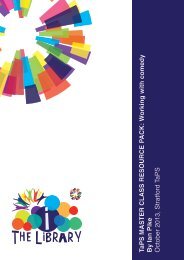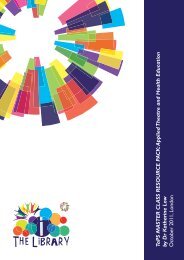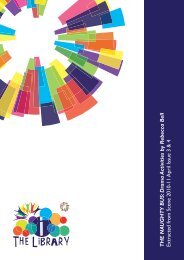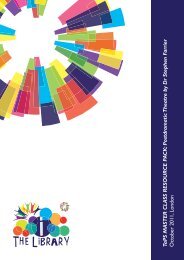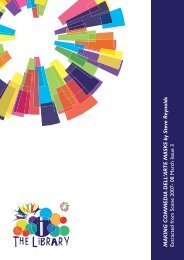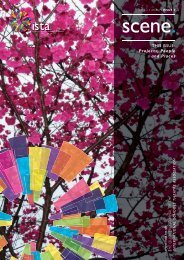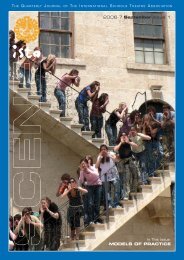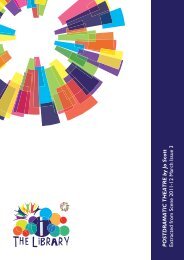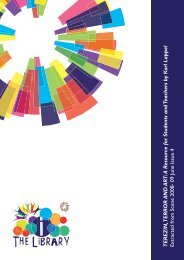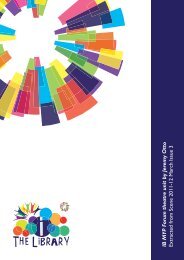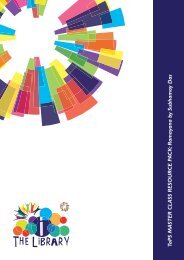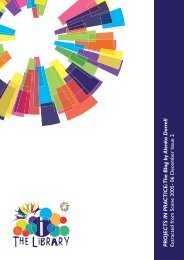ISTA-Scene June 08
ISTA-Scene June 08
ISTA-Scene June 08
- No tags were found...
You also want an ePaper? Increase the reach of your titles
YUMPU automatically turns print PDFs into web optimized ePapers that Google loves.
Devising Theatre and Drama in Education:WORLDS APART?by Jeff AitkenJeff is currently Theatre Managerand Head of Fine Arts at EscuelaCampo Alegre (ECA), theAmerican international school inCaracas, Venezuela. He isexaminer and an approvedTeacher Workshop Leader for IBTheatre. He is also <strong>ISTA</strong> RegionalRepresentative for Latin America.Like many of you, I have enjoyed years ofdevising theatre, both in the classroom andin the community. I am equally passionateabout the many forms that devised theatremay take: site specific, experimental,educational, political and more, and find theeducational and artistic benefits of devisingone of the inspiring aspects of teachingdrama. Implicit in devising are collaborativequestions about ourselves, our relationships,families, communities, politics, and the manyforms of theatre that give voice to the issuesthat impact us. Sometimes the answers areforthcoming, but often the value is in the“getting there”. As teachers, the “gettingthere” is fundamental to what we do,because, although we tend not to directdevised theatre, as facilitators we need toprovide a structure in which it can happen. Inrecent years, I have come to evaluate howbest I can vary the “structures” I provide forstudents during the devising process; afterall, one of the many silver linings in devisedtheatre lies in its possibilities for reinvention.Devising allows for a constant redefinitionof theatrical performance (DevisingTheatre, Alison Oddey, 1994: 23).So in an attempt to revitalize the“structures” of the devising process, I foundmyself re-connecting to earlier days,specifically in the area of Drama in Education.Years ago, at the University of Windsor, I didmy undergraduate degree in Drama inEducation and was introduced to the magicof Dorothy Heathcote, Gavin Bolton, DavidBooth, Richard Courtney and Brian Way. Weexplored the power of play, the teacher-inroleand the value of Story Drama.In the years that followed Windsor, itappeared that I had forgotten the potential ofsuch magical means. Perhaps forgotten isn’tthe best word – necessity dictated that Ishape myself as a teacher well-versed inacting techniques, production elements andpractitioners from times past. Drama inEducation for me took a place on the uppershelf, quite likely due to a system that placedsuch great emphasis on acting lessons andthe school play. At any rate, on the shelf nomore, dust cleared, I have started to rediscoverthe value of Drama in Educationand its place in the devising process.Drama, which has been described as‘the human process whereby imaginativethought becomes action’, is more than just aperformance on stage: as Brian Way states itis ‘a rehearsal for life’... (R. Courtney in ATheatre in Your Classroom, Bernie Warren(Ed), 1991: 4).In the following paragraphs, I will focuson two areas: in Part One, some of thecurrent approaches to devising theatre, ineffect, some of the “structures” that may beapplied to the process; in Part Two, somepractices within Drama in Education that Ihave found to ignite my approach todevising. The following commentary iswittingly infused with quotations, mainly forstudent reflection, but also to provide links towhat I believe are some outstanding sourcesin these fields. By no means can mydiscussions here be completelycomprehensive, but it is my hope that thequotations and sources will generate somepossibilities for incorporating Drama inEducation into the devising process.Part One - A Structure for DevisingI know what you’re thinking – this titlereads as somewhat of a paradox; after all, theessence of devising is rooted in the premisethat there is no structure, no definitive methodand no predetermined final product. Thereare, however, some “contexts” upon whichthe devising process can be based, and asyou’d expect, they allow for variation anddeviation. The contexts are neither intendedto be sequential nor are they meant to beused exclusive of one another. By no meansoriginal, they come from a number ofsources, a number of projects and a numberof people.Context One: ResearchingResearch, whether part of text-based ordevised theatre, is fundamental to theauthenticity of any piece; it involves theacquisition of theatre knowledge fromdifferent cultures and historical periods andits application to practical performance.Research develops devisers’ depth ofunderstanding of issues and topics. It is anopportunity to delve into the differentworlds…allows you to communicate with theaudience on a variety of levels. Your piece islayered, the complex understanding reflectedthrough subtext, characterization, anunexpected scene or image or in set designor costume. You make available to theaudience what you understand. If you haveonly one layer, that’s what they’ll get.(Devising: A Handbook for Drama andTheatre Students, Gill Lamden, 2000: 10)It is important to consider that researchneed not only take the form of individualreading or browsing of the Internet.The starting point may be theme,concept or even a story – research is acollective responsibility – It is from researchwhether book-fed, style-fed or life-fed thattheatre is made. BUT action arrives beforeword! (Through the Body, Dymphna Callery,2001: 165)Some of the best research practicescome from group-work and combiningacquisition of knowledge with action… and Iguarantee the sources are endless:• Books, magazines and the Internet –acquire and connect to performancepractice.• Photos, art and photography books –reflect, copy, edit, collage and improvise.• Interviews and questionnaires in thecommunity – contact a range of members,reflect and write.• Performances, ceremonies, rituals –experience, record, discuss and improvise.• Newspaper articles and maps – comparethose from different times and cultures.• Museums, galleries and tourist offices –use visits and pamphlets to createhistorical/cultural narratives.• Mosques, synagogues, churches, andtemples – experience the diversity andbeauty of each. Record, respond andimprovise.Context Two: CreatingCreating involves the doing, theshaping, or the making of the piece andcertainly has more variations than I couldpossibly summarize, but it is worth notingthat early on it is important to challengetraditional roles most often associatedwith text-based theatre.Actors or practitioners challenging theidea of actor-as-interpreter and reclaiming thenotion of actor-as-creator (Callery, 2001: 161)The first and most fundamental aspect ofeach context is the participants: who theyare and what they bring to the drama interms of experience, expectations and skills.The early part of the rehearsals is aboutinitiating and the latter is about responding(Devised and Collaborative Theatre, APractical Guide, Tina Bicat and Chris Baldwin(Eds), 2002: 98)Create a working atmosphere, one oftrust and confidence…I value energizers andhaving fun. Explore what we play and why.(Lamden, 2000: 9)Take time to explore details, establishgoals, roles and even a few rules.A high degree of democracy in all areasof the work, equal input... I prefer the term‘creating’ rather than ‘devising’ – creatingimplies a single vision but with the creativeimagination of others being given theopportunity of being involved (Oddey, 1994: 54)The shaping of material may begin fromcountless stimuli, and may be exploredcollaboratively through a variety of approachesand performance skills using both traditionaland non-traditional theatrical forms.• Exercises – introductory, physical warmups,trust, ensemble/complicite,<strong>Scene</strong> | 2007-8 <strong>June</strong> Issue 4 | 17



